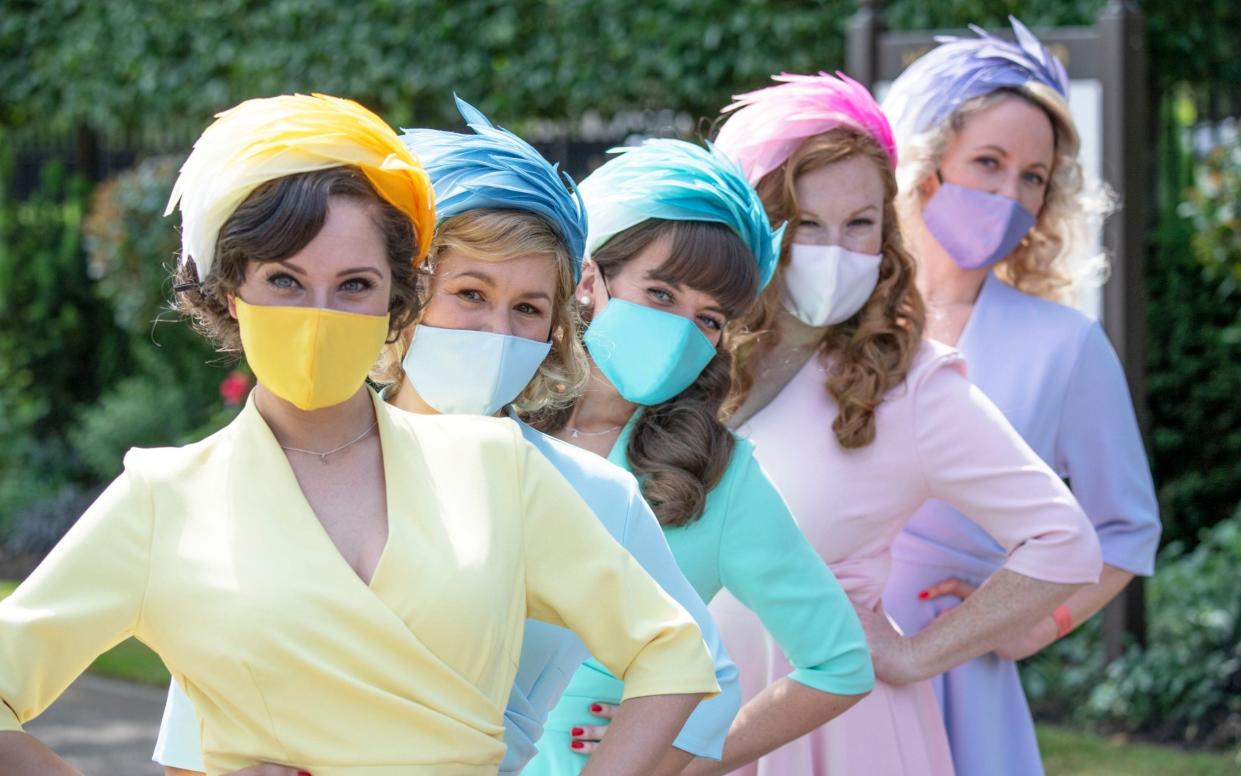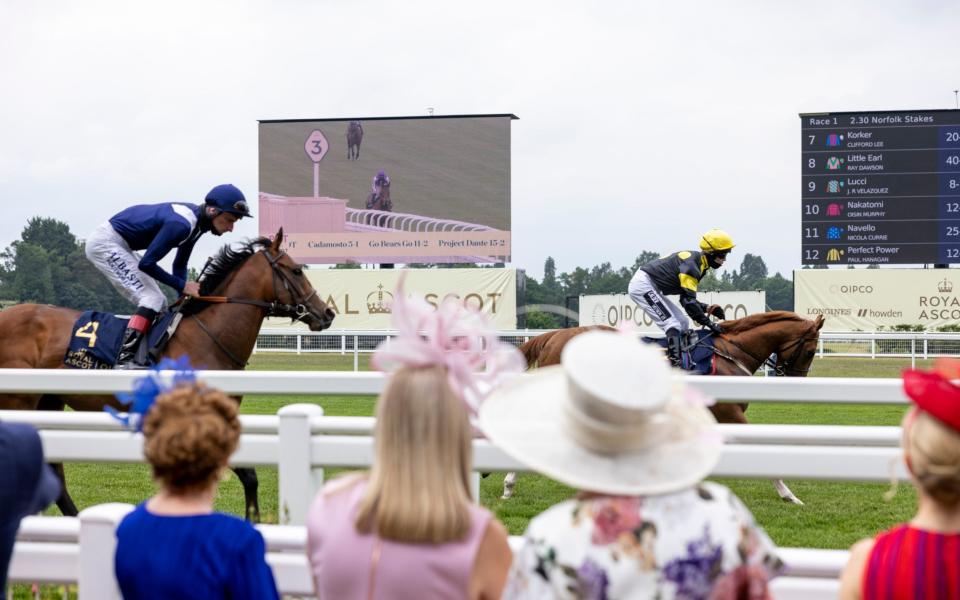How Covid saved Royal Ascot

Royal Ascot has been very different this year: crowds limited to 12,000 a day, compared with 70,000 or more pre-pandemic. No carriage drive up the course, and the sad absence of the Queen at her own race meeting. Even Ladies Day – or ‘Frightful Thursday’, as it has lately become known – passed without too many outrages to public taste or decency, despite attendees having being encouraged, in a puzzling gesture prompted by the Covid crisis, to buy their dresses from charity shops.
But, beneath the shadow cast by the pandemic, there has been a distinct lack of the sheen that once distinguished Europe’s best-attended race meeting, the requirement for masks merely underlining the need to look again at how Royal Ascot lost its glamour – and how it might reclaim it.
For a start, this year’s slimmed-down meeting (after it was closed to the public altogether in 2020) ought to have been the perfect time to end the tyranny of the black top hat.
Royal Ascot used to be the essence of England in mid-summer. This one fashion faux pas has helped turn what used to be a garden party with horse racing attached into the closest thing to hell in the home counties. A grey, felt top hat went perfectly with morning dress for such an occasion, not the funereal stovepipe as worn by a po-faced undertaker in front of an East End gangster’s cortege.

During the first two decades of this century, the Paddock, Grand Stand and Royal Enclosure have become dominated by the black silk topper, so much so that the race meeting has resembled a convention of Victorian coal owners colluding to cut the miners’ wages.
The Duke of Edinburgh was among the last men still faithful to grey. Prince Charles, who dislikes Ascot as much as his father did and always leaves as soon as possible, has a grey topper but then succumbed to black, possibly persuaded by a valet that it’s fashionable. Why? Simply because silk hats are much more expensive than felt ones.
Black hats at Ascot look particularly absurd when a Middle Eastern sheikh enters the Paddock surrounded by his bodyguards, each identically dressed like a pallbearer. If it were a Marx Brothers comedy, you would laugh out loud. And maybe ridicule is the best way to end this vile fashion mistake.
It would be a good first step away from the horror show that I fear Royal Ascot has become.
In a normal year, it starts even before you arrive. Sitting in a five-mile traffic jam several years ago, trying to enter the course established by Queen Anne in 1711 as an ideal place “for horses to gallop at full stretch”, I began to wonder why I bothered when there were more convenient traffic jams closer to home.
Royal Ascot has simply lost its class and allure. The decline dates from the opening of the new £220 million grandstand in 2006, with its 10,000 square metres of plate glass – the world’s only airport terminal in search of a runway.
This monstrosity enables Ascot Racecourse to rent out 247 private boxes starting at £1,250 per day, not including food and drink. One box is big enough to seat 80. That means far more people can be accommodated on the course than was possible in the 1961 grandstand, which was pulled down in order to make room for it.
That concrete edifice was ugly enough, but at least its private dining rooms, as the boxes were quaintly called, were smaller, taking 12 at a push.

It was the huge cost of the new grandstand, plus the loss of racing revenue during the two years it took to build, that forced Ascot’s management to become blatantly commercial, to service the debt and cover running costs.
Racing has even been extended by a day. ‘Royal Ascot’ used to end on Friday, with Saturday’s racing a dressed-down affair. Not now: Saturday in 2019, the last before the pandemic, attracted 74,417 people, more than any other day.
Hospitality packages can now cost as much as £443.72 – that’s per person, per day. That may be good business, but the magic has gone. In the 1960s, 1970s and 1980s, if you were not a guest in a box, you didn’t have to buy a package requiring a bank loan in order to have lunch and an enjoyable day at the races. Pleasant restaurants were set up in the listed, red-brick Victorian buildings near the main gate. Lunch was available at a price comparable to a West End restaurant. People shared tables.
My wife and I once enjoyed the delightful company of an elderly French couple. Only afterwards did I learn that she was the richest woman in France. Ascot was that sort of place. There were rules and conventions, but it was never stiff or starchy.
Gentlemen raised their (grey) top hats as the Queen’s carriage passed. You never looked up at the Royal Box when the Queen was watching a race. On windy days, a lady gave a generous tip to the uniformed attendant, who provided her with a hat pin. You didn’t try to see what Prince Michael was backing before placing your bet with the same bookmaker.
If Princess Diana and Fergie used their parasols to poke the backside of the royal equerry, it was just taken as good fun. Ascot was, in a word, relaxed. Now, the only things relaxed are the rules governing who is admitted to the Royal Enclosure.
Lord Churchill, the King’s Representative at Ascot at the start of the 20th century, vetted all applications personally. He had three baskets, labelled Certainly, Perhaps and Certainly Not. Now, you would have to be an infamous criminal to be turned down. Would a famous porn star be refused? I doubt it. More people, more revenue.
On my most recent visit in 2016 – when I decided it was too ghastly to go on; it had to change or I had to leave with my memories of happier days there – the Royal Enclosure seemed open to all, whether or not people had the lapel badge that was once absolutely required. In their green velvet coats, the Yeoman Prickers who guard its portals seemed powerless to stop interlopers.

To safeguard its unique character, the Queen used to keep commercialism out of her race meeting. I once asked some American friends to look out over the course and tell me what was different about it. They knew something was odd but couldn’t quite spot what.
“No advertising,” I said. “No posters. No corporate logos. No garish sponsorship. No trade names anywhere in sight. Nothing except a glorious view over course and trees towards Windsor Castle.”
Not now: commercial sponsors arrived years ago. Even the clocks on the course now bear the name of a Swiss watchmaker. It might be desirable for Ascot Racecourse to pay its way, but not if it means losing the very qualities that made it unique, not just in horseracing, but in the world of sport.
To my mind, Royal Ascot had simply got too big. The five-day Royal meeting has been ruined by its own success, regularly attracting 300,000 people before the pandemic, twice as many as 50 years ago. But, because of restrictions, only 60,000 spectators have been permitted this year. It would be a sensible ceiling for next year’s meet: the course would still make money, and it would reclaim lost decorum and relaxed enjoyment of a special day of the races that it used to be. In some way, I wonder if Covid has saved Royal Ascot from its worst excesses.
Take another recent ‘innovation’ that hasn’t helped: the singing around the bandstand after the last race, which is fine for a knees-up at the Old Bull & Bush, but utterly wrong for Royal Ascot. It didn’t happen this year, and it need not return – but if lessons can be learned from these Covid restrictions, there’s every chance that I might.
Michael Cole is a former BBC royal correspondent

